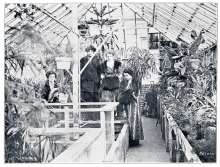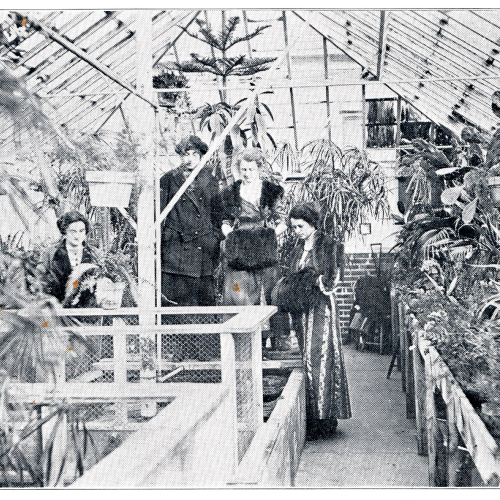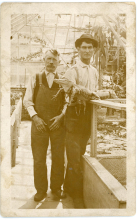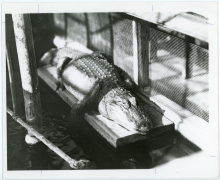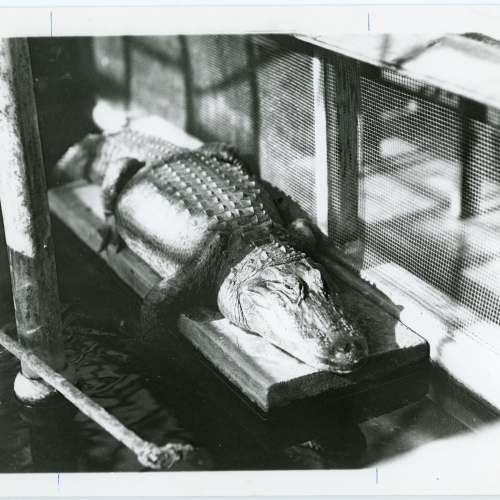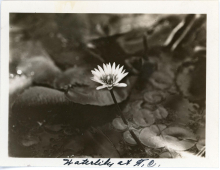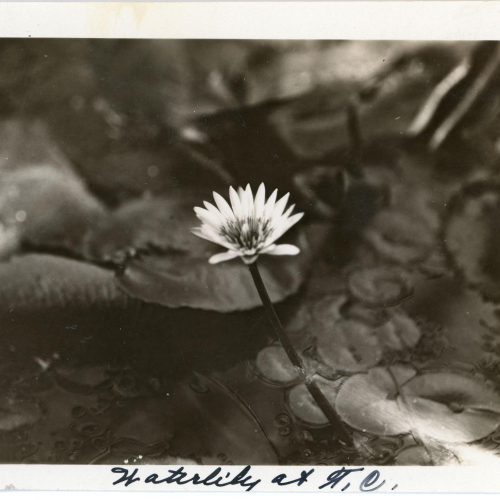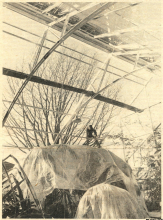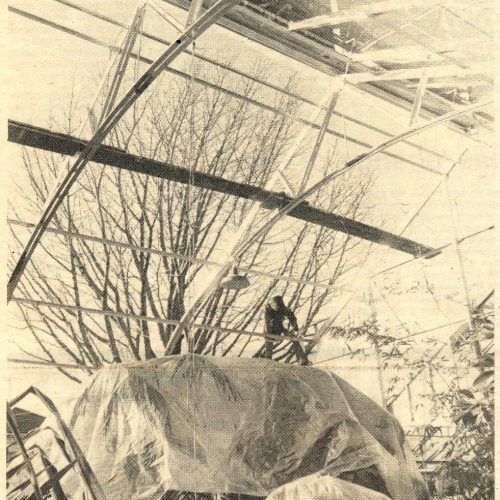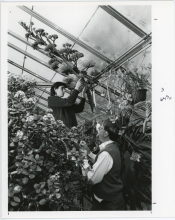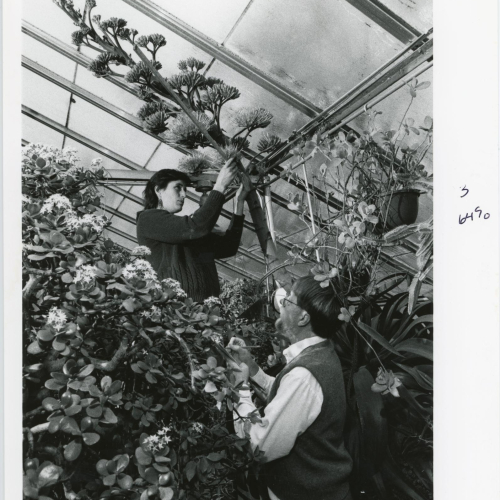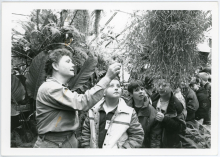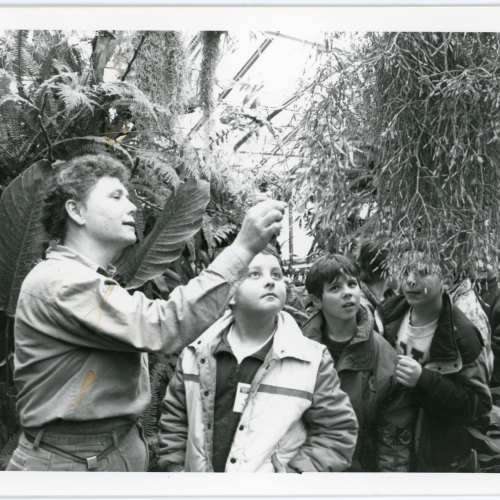Botanical Center (1938)
As early as the mid-1980s, the Greenhouse began to be called the Biology Greenhouse or the Biological Greenhouse to distinguish parts used for classes from those used by the Physical Plant to raise bedding plants for campus landscaping. By about 2000, the term Biology Botanical Center began to appear and in 2006 the Greenhouse was officially renamed the Biology Botanical Center. Around 2000, students and staff members at the Greenhouse wrote a brief history of the facility now known as the Biology Botanical Center. That essay, which is available in print format in University Archives, outlines the early history of the current structure and does a fine job of describing the developments in facilities, staff, and collections in recent years. The essay below is a complement to the 2000 essay; it provides the historical context that led to the initial construction of the current facility and provides greater detail on the earlier years of that facility.
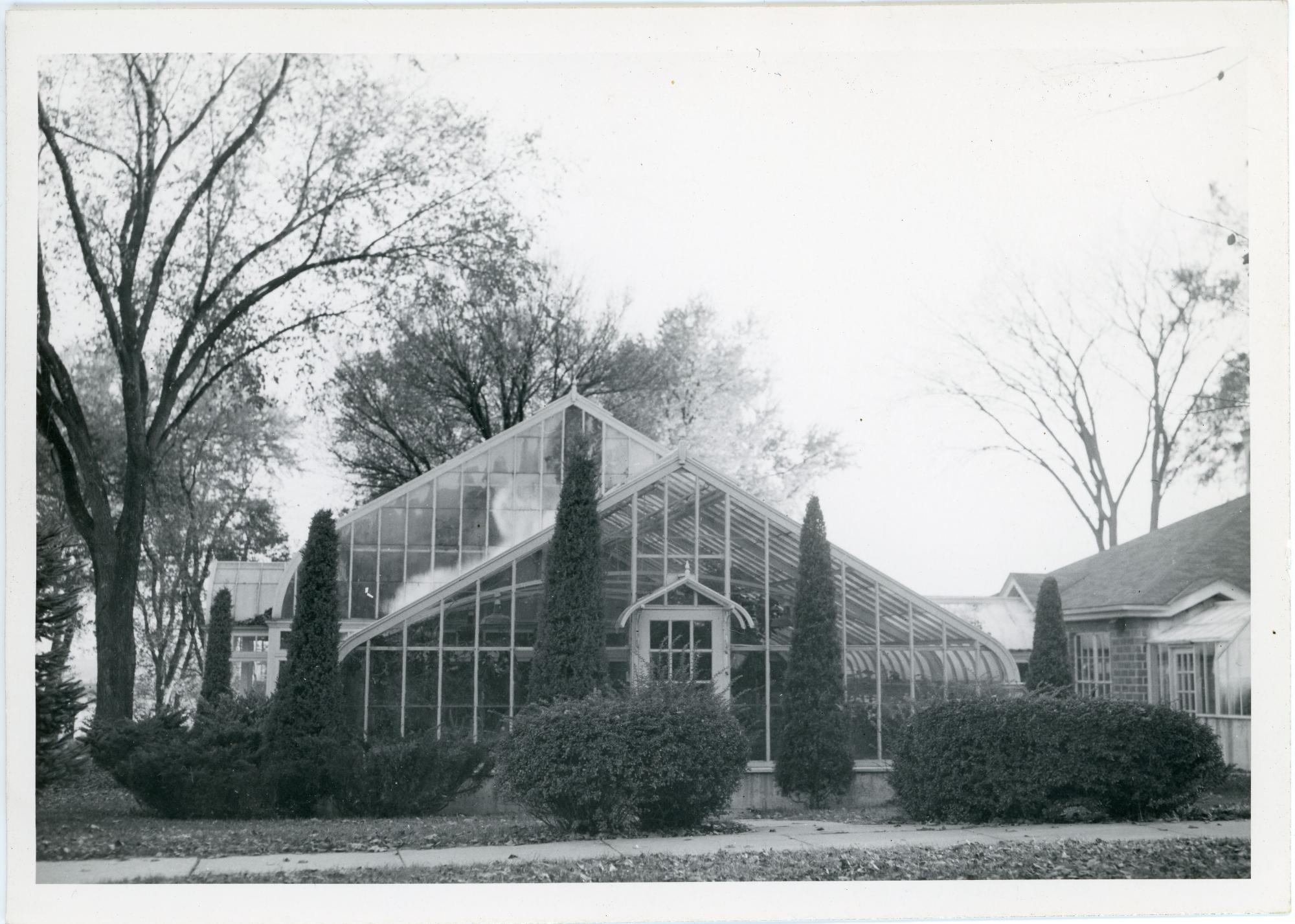
Early Greenhouses
Science classes had been offered at the Iowa State Normal School, now the University of Northern Iowa, since the school opened in 1876. In 1892, there was even a brief differentiation of the faculty and curriculum into quasi-departments of Natural Science and Physical Science. Laboratories, equipment, and demonstration facilities for the sciences appeared fairly early in the school's history. Microscopes were in use on campus by 1880. New natural and physical science laboratories became available when the third floor of the Administration Building opened in September 1896.
In June 1903, construction began on the Laboratory Building, now known as Begeman Hall. That building was ready for use in September 1907. Geography classes, then part of the Science Department, occupied the first level of the building. The rest of the building was devoted primarily to work in chemistry and physics.
Around the same time, the natural sciences started benefitting from new facilities too. Probably the earliest reference to a campus greenhouse appears in the minutes of the Board of Trustees, July 24, 1906: "Moved by [Roger] Leavitt that $300.00 be appropriated for a Green House, heating and plumbing to be extra." The minutes do not include a specific site for the new building.
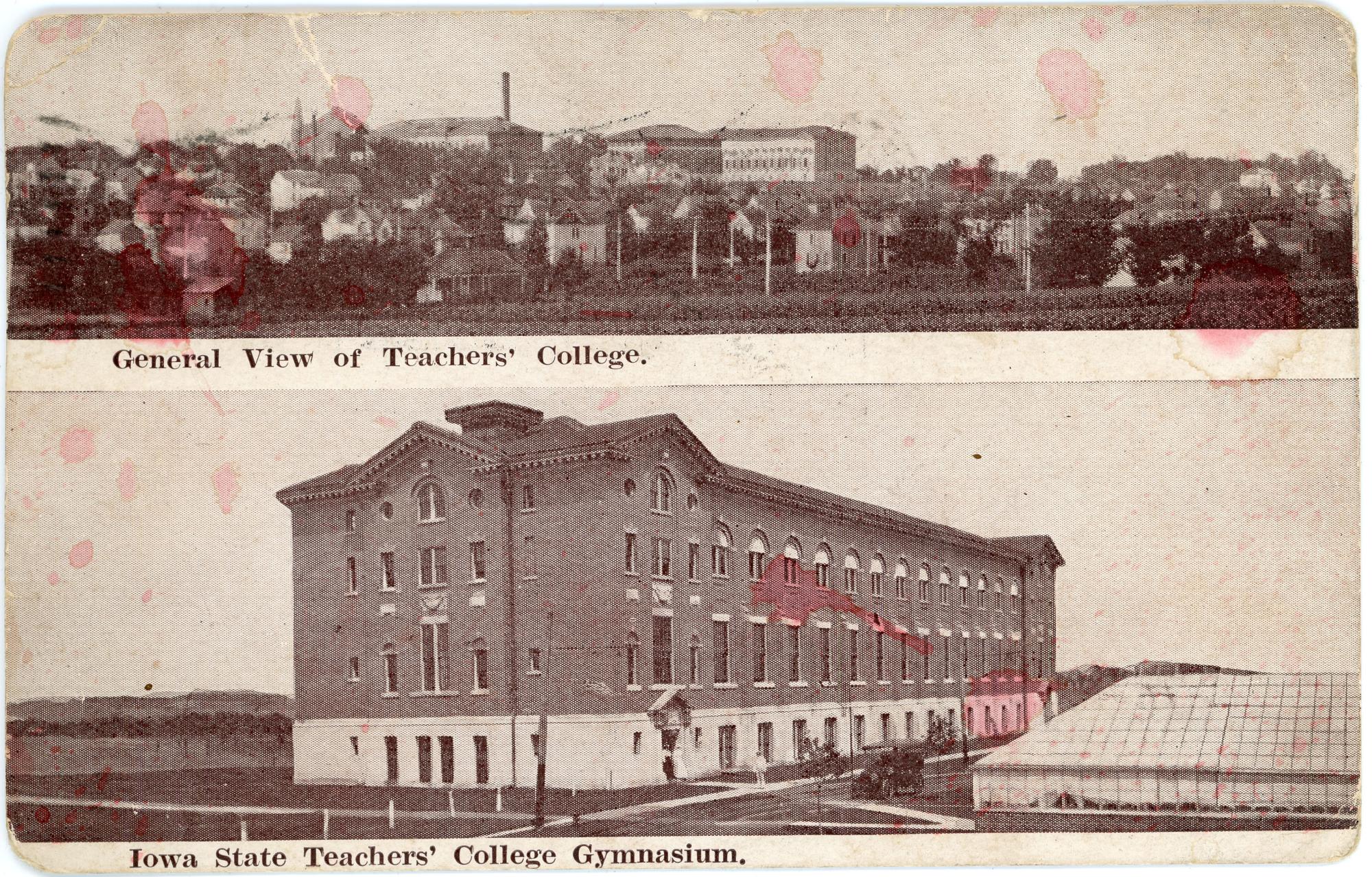
The site for the greenhouse was southeast of the newly-constructed Gymnasium, now known as the Innovative Teaching and Technology Center. It stood about where the northwest corner of the Maucker Union expansion is now located. This central campus location was convenient for students and faculty. Locating it near the campus power plant, which was in the center of campus, may have been a factor in its location. Just a few weeks after the Board's decision, on September 19, 1906, an editorial writer in the student newspaper, the Normal Eyte, praised the plan to build a greenhouse.
"Heretofore we have been somewhat handicapped in that general botany could not be offered in the winter. This difficulty will soon be alleviated and the study of botany may be pursued year round."
The writer went on to say that work in the natural sciences would be greatly improved by having access to a greenhouse. It is interesting to note that even before it was built, the first greenhouse was linked directly to the school's curriculum.
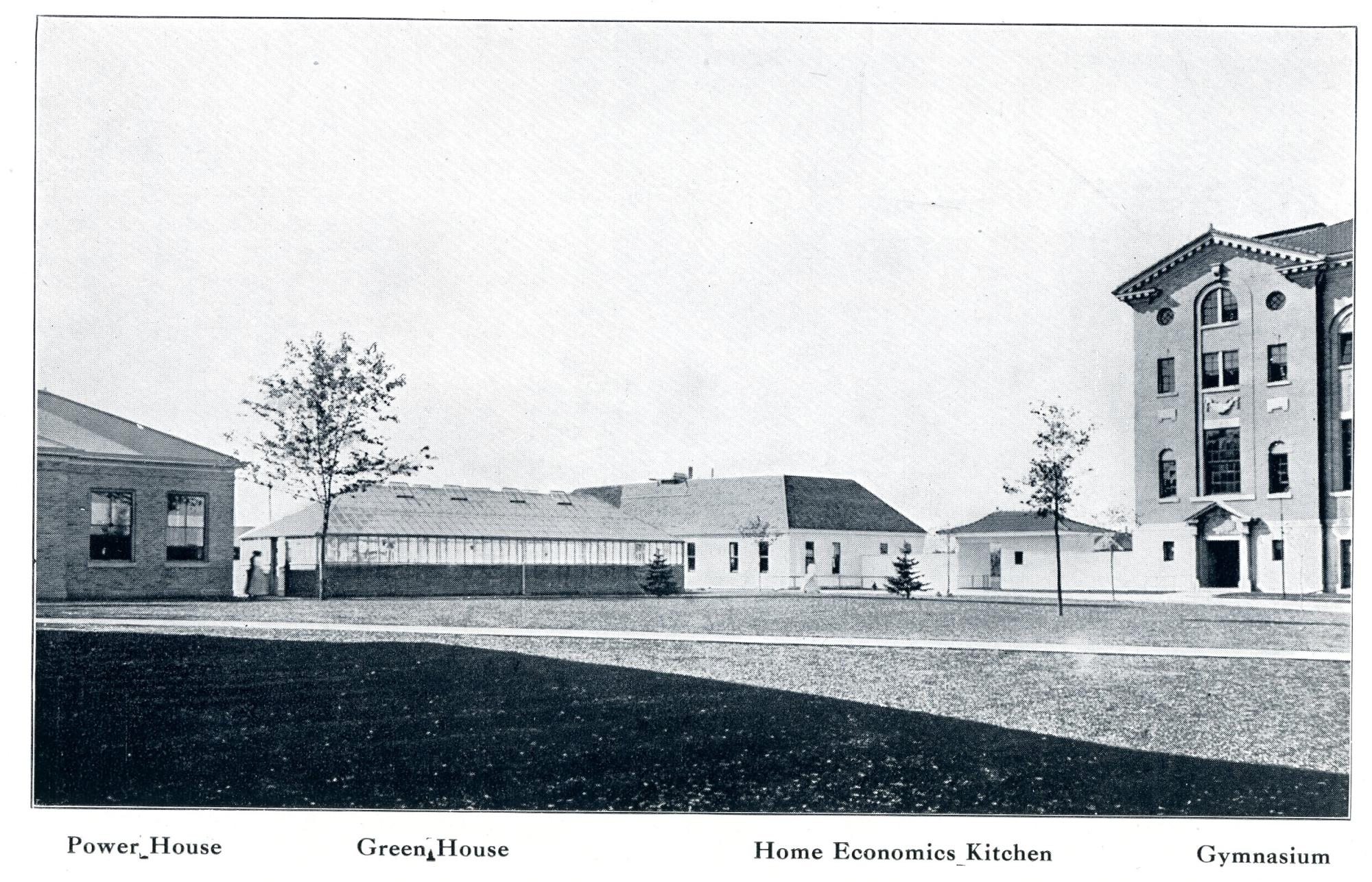
The greenhouse was completed relatively quickly and soon took on roles that would become well-established functions. Most important, of course, the new building provided laboratory facilities for work in natural science classes. It also provided plant displays as part of its regular collections. Already in 1908, it included an aquarium stocked with dogfish, bullheads, carp, suckers, crappies, bass, pickerel, turtles, and clams that had been taken from a local pond. Students enjoyed visiting the aquarium, which was under the direction of Robert Billings, the campus gardener. President Seerley himself, in his column in the student newspaper, urged students to visit the greenhouse and "spend an hour learning the names of the plants that are growing so finely." In all likelihood, the building served as a cutting and propagation house for campus shrub and flower beds, meaning that even in January, students could enjoy blooming roses and carnations, as well as beautiful foliage.
Just a few weeks after the Board's decision, on September 19, 1906, an editorial writer in the student newspaper, the Normal Eyte, praised the plan to build a greenhouse:
"Heretofore we have been somewhat handicapped in that general botany could not be offered in the winter. This difficulty will soon be alleviated and the study of botany may be pursued year round."
In the summer of 1909, the aquarium was enlarged and improved. Two large concrete pools were added. One pool would house a young alligator and water plants, especially water lilies. The other pool would house game fish such as bass, pike, and pickerel. By October, the game fish ponds were stocked with fish brought from the north side of the Cedar River near Cedar Heights. Once again, President Seerley promoted this new school feature:
"It is well worth while to spend an hour in the greenhouse getting acquainted with the different kinds of Iowa fish in the aquaria. The undertaking is meeting with excellent success as the aquaria are so well managed that the fish seem to prosper there as well as in their native element. These additions to natural history are of great benefit to the instruction in the line of water life."
Two more inhabitants, two monkeys named Jocko and Maud, arrived at the greenhouse in the fall of 1909. They were, sadly, destined for a brief stay before they were mounted as exhibits in the school museum.
In May 1910, the Board of Education, predecessor to the Board of Regents, met to consider enlarging the greenhouse, but it is unclear if any significant changes to the structure were made at that time. Students apparently continued to enjoy visiting the greenhouse both for class work and for entertainment.
Once the initial flurry of interest passed, campus publications were largely silent on the greenhouse for almost fifteen years. As early as the summer of 1915, college officials were considering a second greenhouse to be used in association with classes in vocational agriculture. That greenhouse, located south of the Vocational Building, now called Wright Hall, was completed in the fall of 1919. Its location was close to the current Biology Botanical Center.
In 1924, a story appeared in the student newspaper that was the first of many similar articles to follow over the years. Back in 1909, the college had announced plans to keep an alligator in the new greenhouse, but, other than the 1913 yearbook photo above, which may or may not show an alligator tank, there were no reports on whether or not this actually happened. However, in 2013, a donor gave the picture posted above to the University Archives. A handwritten note on the back says that the photo was taken in the Teachers College greenhouse in about 1921. Whether or not that citation is accurate, the 1924 article left no doubt: there was indeed an alligator in the greenhouse. The article stated that in 1909, Joy Harmon, of Washington, Iowa, brought three young Florida alligators to campus in a shoebox. Two of the alligators refused to eat and died shortly after their arrival, but one, named Allie, prospered. By 1924, it was six feet long. Greenhouse officials tried at least twice to introduce a second alligator, but one died trying to escape and the second died of exposure when a storm blew off part of the greenhouse roof in 1927. The survivor, Allie the Alligator, would become a staple for campus feature story writers for decades to come.
Reporters seemed especially taken by the alligator's appetite for chipmunks, rabbits, squirrels, and crows. Reporters also enjoyed visits with a family of snapping turtles and the occasional monkey, who wintered on campus and summered in local parks and zoos.
The New Greenhouse
In December 1933, President Latham drew up plans for improvements to the college buildings and grounds. These plans would be submitted for funding to the Civil Works Administration, a federal agency set up during the Depression to provide work for those who were unemployed. Included among these proposals was a new greenhouse. Funding was slow to materialize, so students continued to enjoy the alligator, the monkeys, and exotic plants, such as the mimosa, in the old greenhouse.
In the summer of 1936, the college announced a number of campus improvements that would be funded by state appropriations totaling about $60,000. Along with a new laundry, improved lighting, landscaping, and roads, the college would also have a new greenhouse. It would be built on "the eastern half of the wooded lot" south of the Vocational Building, now Wright Hall. Because this site was a bit low, the elevation was raised with fill dirt. However, this would later cause settling problems for the structure.
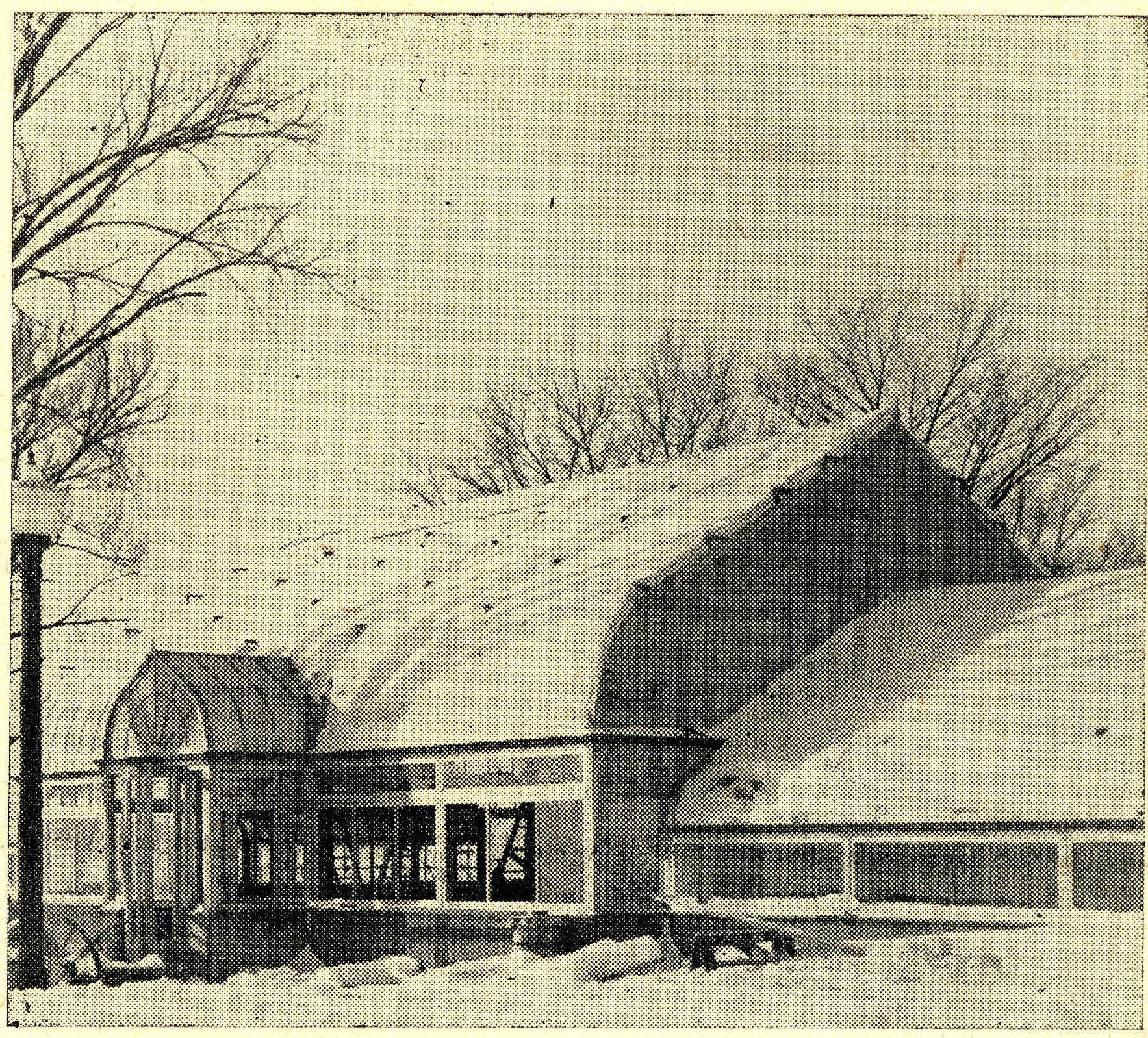
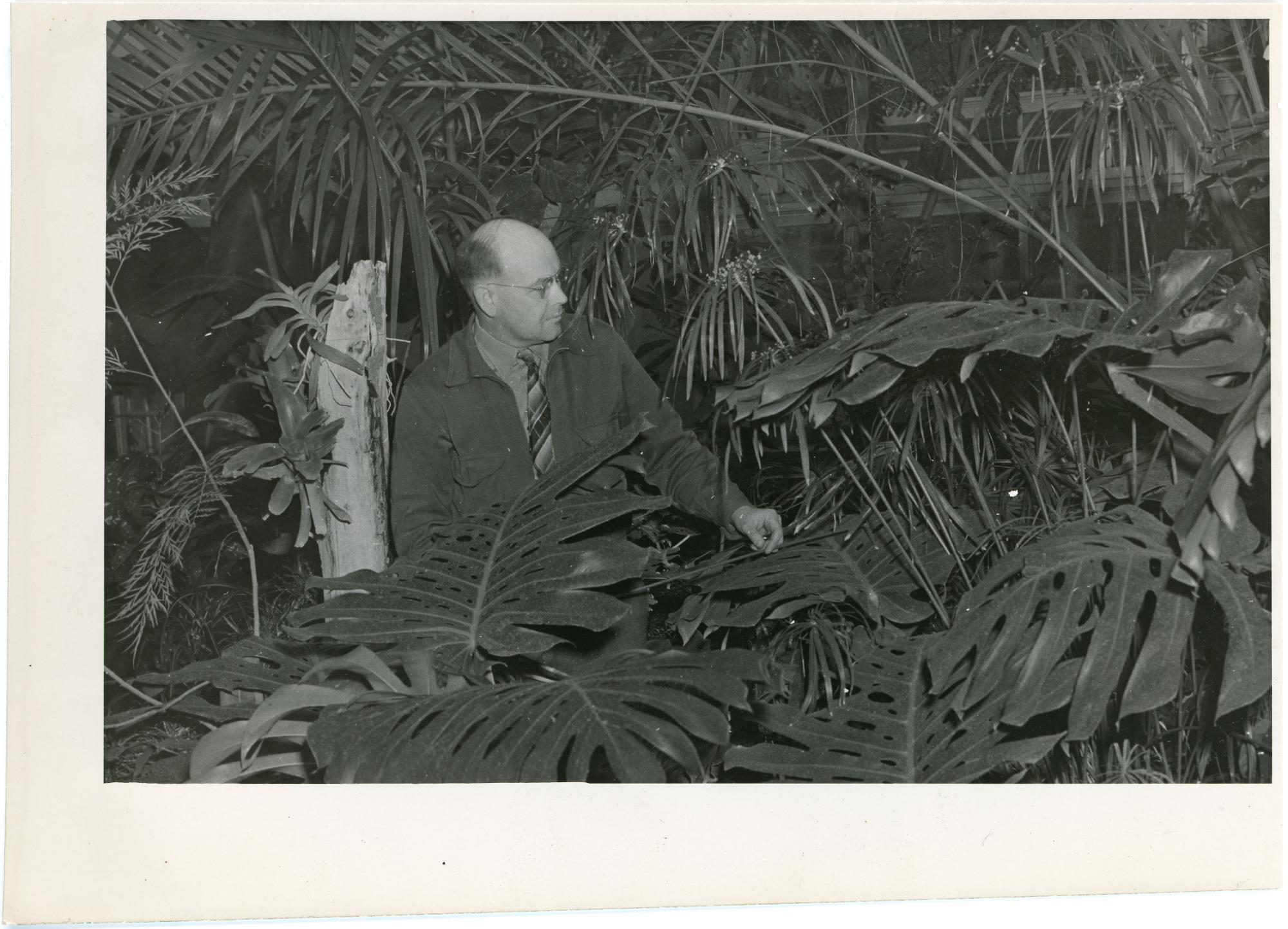
By the summer of 1937, the old greenhouse was getting a bit rough-looking. An article in the College Eye described it as a "little, old, and unpainted building" that belied the treasures it held. The article noted that caretaker Roger Wardin pointed out a rubber tree, a calla, a hoya, a crown of thorns plant, and an orange tree. He also described the animals that lived there: goldfish, a bullfrog, turtles, and Allie, now eight feet long. Just two weeks after this article appeared, Allie managed to get out of his tank and onto the greenhouse floor. Greenhouse staff somehow got him back into his tank.
Shortly thereafter, the staff faced another problem. How would they move Allie to his home in the new Greenhouse that was expected to be completed by the spring of 1938? Their solution involved a long crate. The new Greenhouse, costing $30,000, had been built in a factory, disassembled, and sent to campus, where it would be re-assembled. It would include a tropical house, two display houses, a service area, and two units for science classes. By early February 1938, the Greenhouse structure was up and the glass was in place.
However, as it turned out, the new Greenhouse did not include a pool for Allie. Through the spring and early summer, articles appeared in the College Eye about the alligator's plight, but no one stepped forward to offer a new home. On July 19, 1938, the alligator was shot and given to biology students for dissection. They discovered that Allie had been a female. She was about eight feet long and about thirty-two years old. Her skin and skeleton were preserved. Many on campus were saddened by the whole matter.
Interestingly enough, a brief College Eye article on the newly-completed Greenhouse, appearing in the summer of 1939, noted that there was a new baby alligator living there. A few months later, another story amplified the news. There were TWO alligators in the house: Ike and Mike. They were about twelve years old and about two feet long. A man from Davenport donated them. They lived in the biological laboratory of the Greenhouse. Later, a new Allie the Alligator began to make Greenhouse news. According to reports, this Allie had been obtained in trade with a zoo in about 1950; the zoo needed an older alligator, so the Greenhouse traded its alligator for a younger one. Whichever alligator this actually was--Mike, Ike, or one from the zoo--it was about sixteen years old and about five feet long. It lived in a 39 X 32 inch cage. Student Terry Knapp believed that it deserved a bit more space, but the Student Senate rejected a request for $100 to provide better living conditions. Mr. Knapp and John Volkers began a campaign to raise money to enlarge the alligator's quarters. Shortly after, student Dave Krause announced that Allie was a candidate for the presidency of the Student Senate. He claimed the alligator stood for better housing and recreational activities for all students. The alligator, a write-in candidate, received 640 votes for various offices in the election, which attracted a surprising amount of publicity both on and off campus. He actually won enough votes to be elected a senator in one race. Eventually, students raised enough money to enlarge Allie's cage. Two years later, in the spring of 1969, Allie received enough votes to win the office of Secretary of Off-Campus Men. Allie, unfortunately, did not live long enough to enjoy the political spoils. He died during the week of July 11, 1969.
Students quickly came to enjoy the exotic plants in the new Greenhouse. They wondered at the carnivorous plants such as the Venus fly trap, the pitcher plant, and the sundew plant. They marveled at a banana tree actually bearing fruit in Iowa. The edible and medicinal nature of some of the specimens was a favorite topic for staff member Roger Wardin to talk about.
In 1940, a visitor to the Greenhouse could find oranges, grapefruit, pineapple, tomatoes, passion fruit, guava, melon, loquat, figs, coconuts, and dates, as well as spices and herbs. Mr. Wardin was proud of his hydroponic methods for raising vegetables and fruit. He also started poinsettia and shrub cuttings for later use around campus. The Greenhouse of that era included frogs, tadpoles, snapping turtles, toads, Gila monsters, snakes, rats, hamsters, and lizards. There were even, on occasion, wild animals recovering from injury or needing assistance, such as a blue-billed duck in 1940, a pair of young great horned owls in 1945, a turkey vulture in 1953, and assorted foxes, raccoons, and other birds.
During World War II, students were interested in seeing bananas, papayas, coconuts, and figs. They heard about these plants in letters from relatives and friends who were serving in the South Pacific or North Africa. In the Greenhouse, they could see them and maybe even taste their fruits. By then, Ike and Mike, the alligators, were about three feet long, and there was speculation that one of them was a female. Even though these oddities attracted most of the attention, Mr. Wardin said in a 1946 College Eye article, "The college Greenhouse is maintained entirely for the science department and is used for botany and nature study classes…This is an exceptional greenhouse for a school of this size, well-built and well-equipped." The collection also attracted a steady stream of grade school students on field trips. At one point Mr. Wardin commented that "the grade school children seem to get as much if not more benefit from it than some older students."
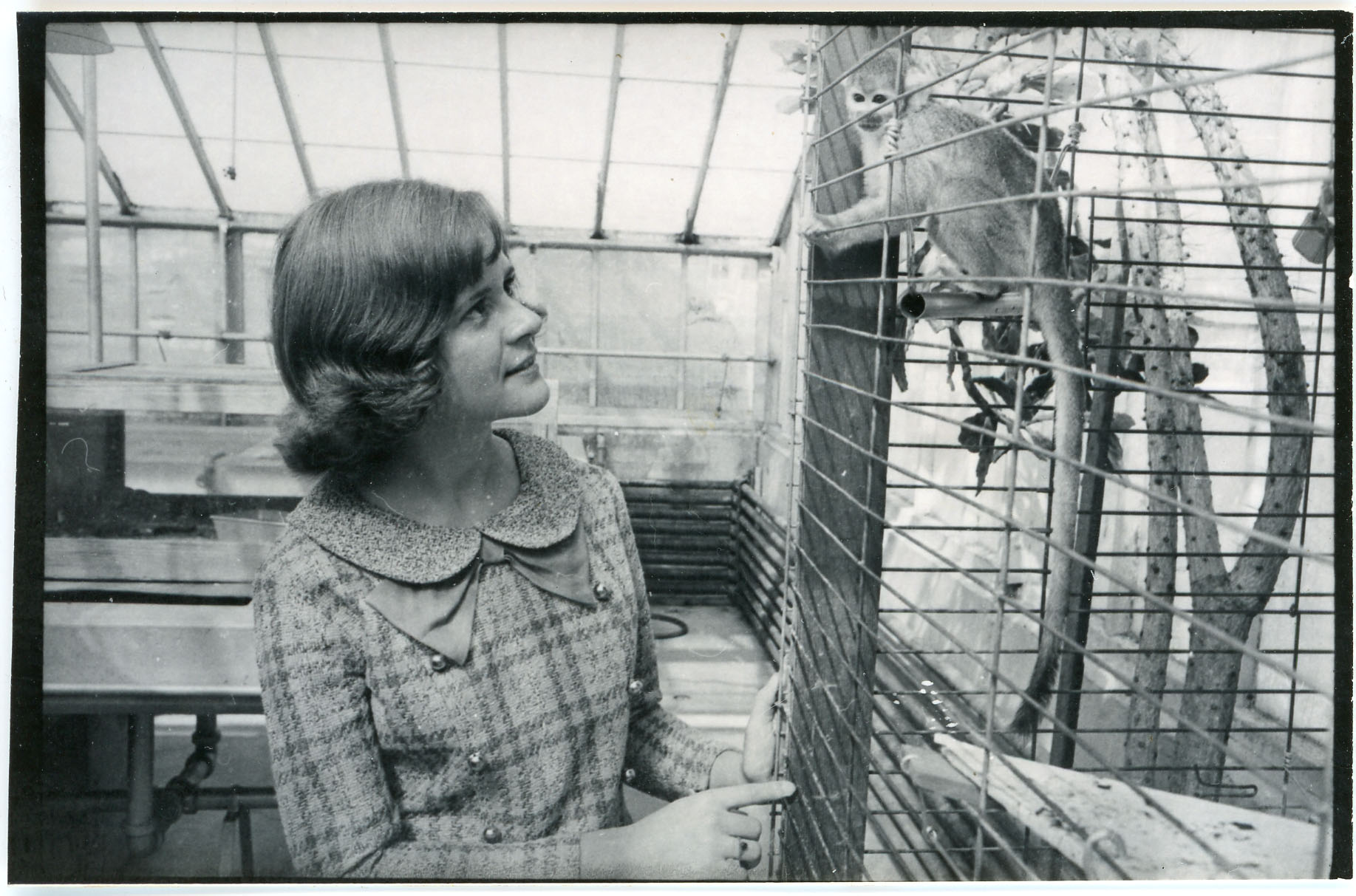
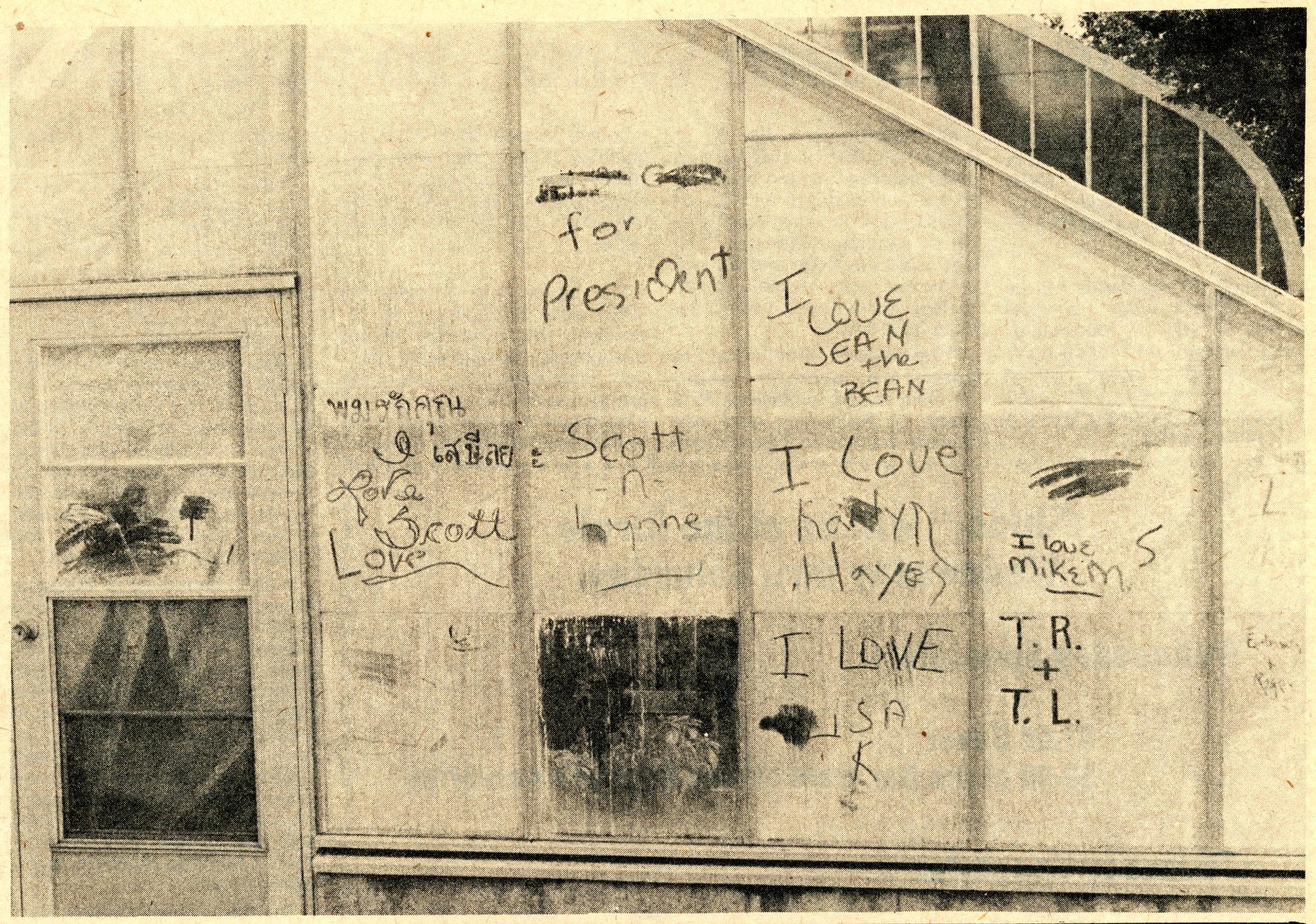
In late 1944, the college began to formulate its postwar plans for capital improvements. Included in these plans, some of which took decades to come to fruition, was an addition to the Greenhouse. On Saturday night, March 21, 1953, a hail storm caused damage estimated at $10,000 to campus buildings. The Greenhouse, where hail shattered over 1,300 panes of glass, was severely affected. Not until Tuesday, after damaged dormitory windows had been repaired, did physical plant crews reach the Greenhouse. By that time it was too late. Many of the tropical plants were killed by the hail, shattered glass, or the resulting lack of heat. Mr. Wardin stated that years of work were lost in the storm.
Thanks to the efforts of Mr. Wardin and his crew, things in the Greenhouse seemed to be back to normal within a couple of years. One 1956 article described the current layout and use of the facility. There were three east units and four west rooms. The central section of the east units contained the tropical plant collection. The other two east units were used to propagate plants for classes and campus flower beds. Two rooms in the west section contained plants for botany classes while animals lived in the other two west rooms. The basement held bulb storage bins as well as breeding facilities for white laboratory rats.
Once again, in 1959, general campus expansion and development plans included an addition to the Greenhouse. In the summer of 1960, work got underway on a $14,200 service building for the Greenhouse. That work was complete by the fall. In late 1963, Professor Warren Picklum announced that the Greenhouse would undergo significant renovation. As a result, most of the collection would be replanted and rearranged. Soil in the floor beds would be removed and replaced. Representative plant families, mostly tropical, would occupy one display house. Larger plants would be in another house. A third house would be for cuttings that would be transplanted to campus landscaping beds. Cacti and water plants would be in other houses. Professor Picklum explained that this renovation would make the Greenhouse a better teaching facility. He also noted that improved environmental control was needed in order to provide better conditions for some of the exotic plants, such as orchids. Over the years, Professor Picklum brought back many specimens for the Greenhouse from botanical gardens and from field trips.
Portions of the Greenhouse underwent extensive renovation in the mid-1970s with new aluminum sash, more efficient glazing, and better ventilation. In a May 1977 Northern Iowan article, Greenhouse manager Ron Camarata gave a good picture of the current collections. He noted that the avocado, banana, lemon, coffee, and cocoa plants were among the most popular.
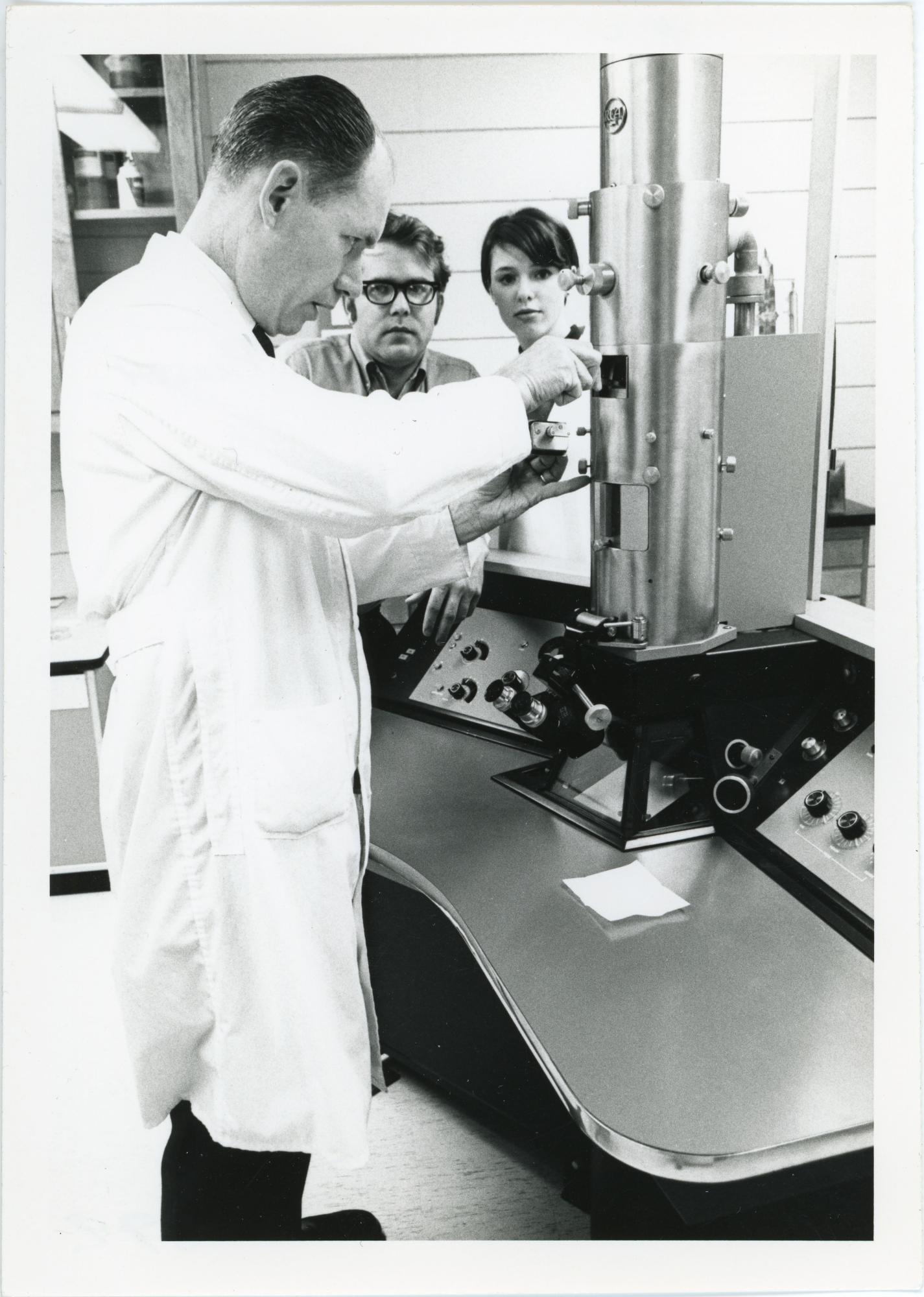
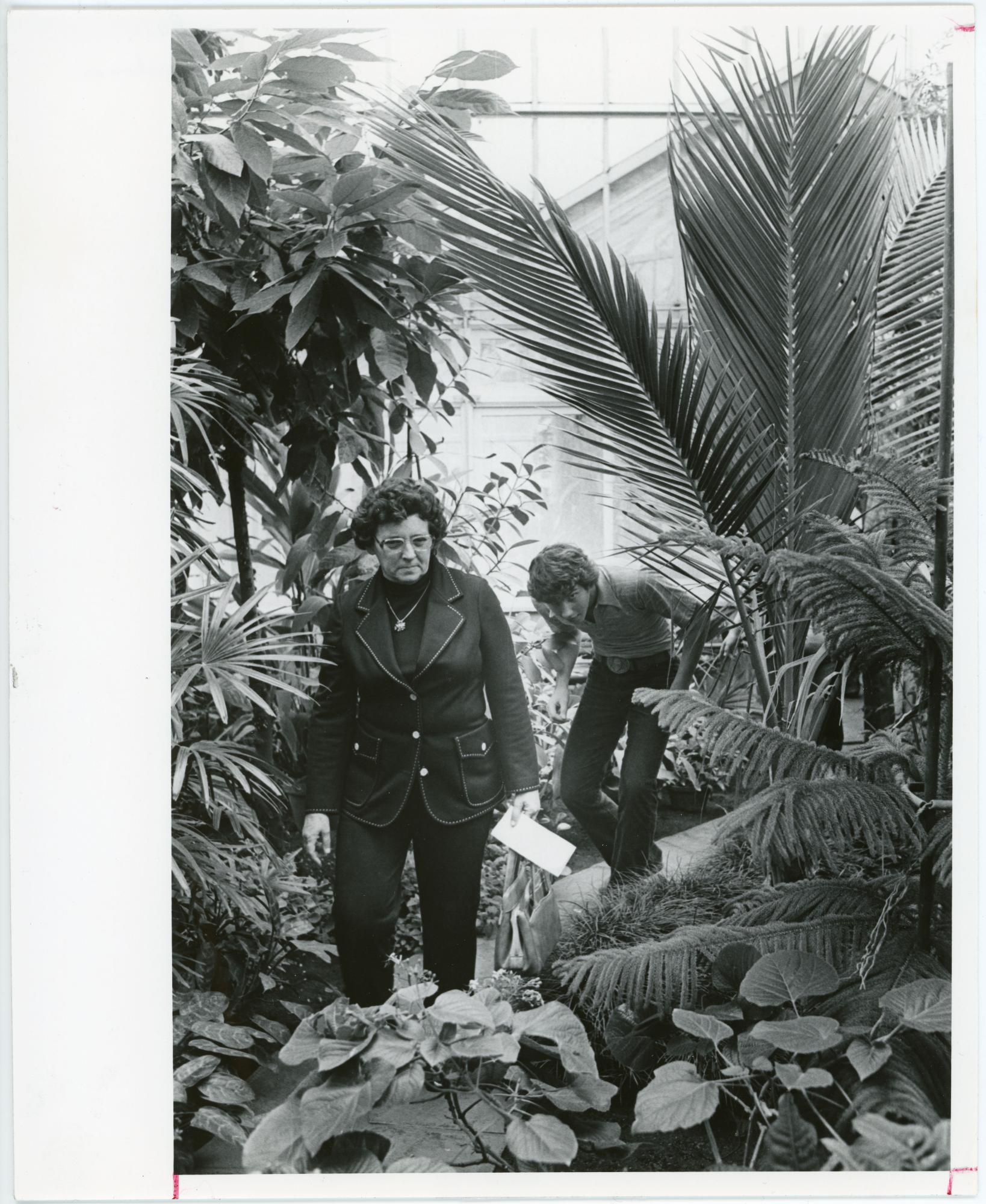
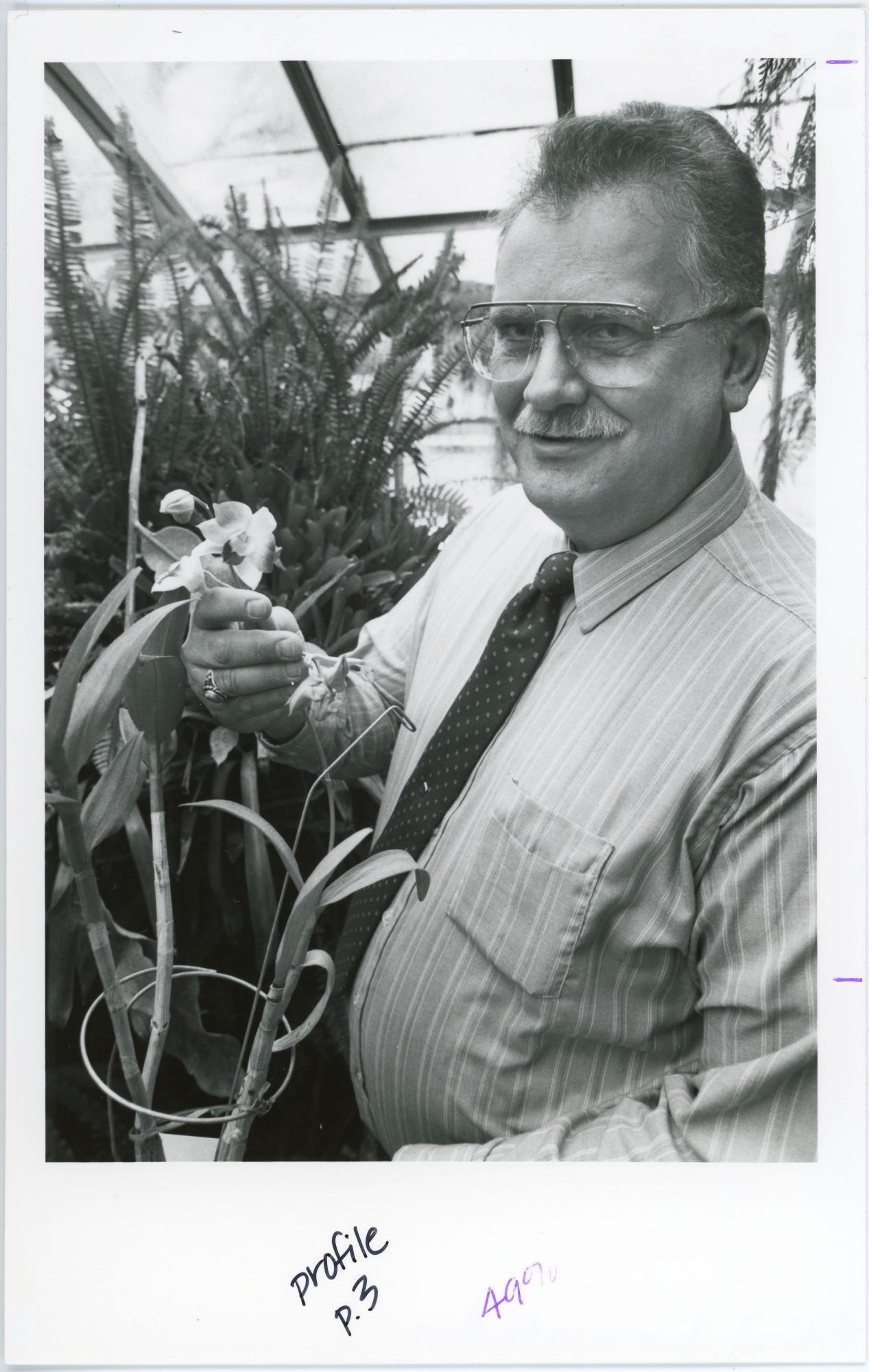
The Greenhouse was sourced by many who could not care for particular plants, i.e., professors returning from field trips and occasional purchases. A surprising number of animals still resided in the Greenhouse too: another alligator, a cayman, turtles, gerbils, rabbits, a chinchilla, prairie dogs, a boa constrictor, bull snakes, a red-winged blackbird, doves, and an iguana. The menagerie fascinated visitors of all ages. Mr. Camarata said that of the 3,500-4,000 annual Greenhouse visitors, about 20% were below fifth grade, about 50% were in grades five through eight, and about 30% were in high school.
In 1981, the tropical house underwent renovation similar to those made in other portions of the Greenhouse a few years earlier. Construction began in October and continued for about five weeks. Cooler weather required that the work proceed in stages to protect the delicate plants. The new aluminum frame and better glazing made for a tighter greenhouse. Ron Camarata said the energy usage was cut in half as a result of the updates.
By 1984, most of the remaining animals had apparently been moved to the Biology Research Complex. Only goldfish remained, but they were something of a harbinger of things to come. Reflecting the growing interest in water plants and aquatic life, room 5 of the Greenhouse began to undergo a transformation into an Aquatic Learning Center in 1997. Initially working with existing tanks, and later expanding into a waterfall, a wet wall, and a ten thousand gallon tank, the new center became an important part of the curriculum and an interesting field trip destination.
Compiled and written by University Archivist Gerald L. Peterson, with scanning by Library Assistant David Glime, November 2006; last updated January 28, 2015 (GP); photos updated and citations added by Graduate Assistant Eliza Mussmann, February 10, 2022; content updated by Graduate Intern Marcea Seible, June 2025.

